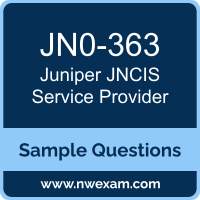01. Which two statements are true about the LACP protocol?
(Choose two.)
a) It exchanges BPDUs to ensure all member links are functioning properly.
b) It monitors and controls the member links that form a single logical channel.
c) It acts in one of two modes: active and passive.
d) It is used to exchange control information between two MC-LAG network devices.
02. An IS-IS level 1-only router is configured within a larger multilevel hierarchy. Which OSPF area type resembles the routing information in the L1 router's table?
a) OSPF default area
b) OSPF stub area
c) OSPF NSSA
d) OSPF NSSA with no summaries
03. From the [edit routing-options] hierarchy, which command correctly configures a default route that will use 43.18.7.1 as its primary next hop and 76.13.10.2 as its secondary next hop?
a) set static route 0/0 76.13.10.2 qualified-next-hop 43.18.7.1 pref 7
b) set static route 0/0 next-hop 43.18.7.1 secondary-next-hop 76.13.10.2 preference 7
c) set static route 0/0 next-hop [76.13.10.2 10.10.10.5] pref 7
d) set static route 0/0 next-hop 43.18.7.1 qualified-next-hop 76.13.10.2 preference 7
04. What must be configured for all IBGP speakers in an AS to have consistent routing information?
a) full mesh of IBGP sessions between IBGP speakers
b) static routes to the EBGP gateways
c) default routes to the IBGP gateways
d) partial mesh of EBGP sessions between EBGP speakers
05. On a Junos device with dual Routing Engines (REs), which two statements correctly describe the expected behavior if the primary RE fails?
(Choose two.)
a) The backup RE will assume the master role once the Packet Forwarding Engine (PFE) restarts.
b) The backup RE will immediately assume the master role.
c) The new master RE restarts the routing protocol process (rpd) and establishes any required adjacencies based on the configuration.
d) The new master RE maintains the existing protocol adjacencies initially established by the previous master RE.
06. BGP update messages contain which two elements?
(Choose two.)
a) path advertisements
b) path attributes
c) path assignments
d) path announcement
07. Under which configuration hierarchy is a load-balancing policy applied?
a) [edit routing-options family inet]
b) [edit forwarding-options family inet]
c) [edit routing-options forwarding-table]
d) [edit forwarding-options forwarding-table]
08. When considering BGP route propagation, which two statements are correct?
(Choose two.)
a) EBGP speakers send routes learned from IBGP neighbors to IBGP neighbors.
b) IBGP speakers send routes learned from IBGP neighbors to IBGP neighbors.
c) EBGP speakers send routes learned from EBGP neighbors to IBGP neighbors.
d) IBGP speakers send routes learned from EBGP neighbors to IBGP neighbors.
09. You have been asked to explain why the 224.0.0.5 address appears in your Junos device’s routing table. Which statement describes the functionality of the 224.0.0.5 address?
a) OSPF is using the address to transmit OSPF link-state request packets.
b) OSPF is using the address to transmit OSPF database description packets.
c) OSPF is using the address to transmit OSPF acknowledgment packets.
d) OSPF is using the address to transmit OSPF update or hello packets.
10. The segment touting SRGB start label is 10,000 and the SRGB index range is 500. In this scenario, which two statements are correct?
(Choose two.)
a) The first usable label is 10,001.
b) The last usable label is 10.501.
c) The last usable label is 10,499.
d) The first usable label is 10,000.
 Before you write the Juniper JNCIS Service Provider (JN0-363) certification exam, you may have certain doubts in your mind regarding the pattern of the test, the types of questions asked in it, the difficulty level of the questions and time required to complete the questions. These Juniper Networks Certified Specialist Service Provider Routing and Switching (JNCIS-SP) sample questions and demo exam help you in removing these doubts and prepare you to take the test.
Before you write the Juniper JNCIS Service Provider (JN0-363) certification exam, you may have certain doubts in your mind regarding the pattern of the test, the types of questions asked in it, the difficulty level of the questions and time required to complete the questions. These Juniper Networks Certified Specialist Service Provider Routing and Switching (JNCIS-SP) sample questions and demo exam help you in removing these doubts and prepare you to take the test.